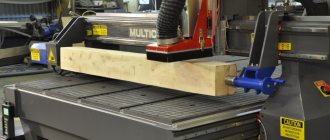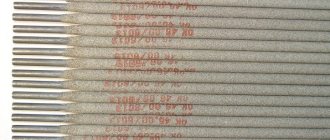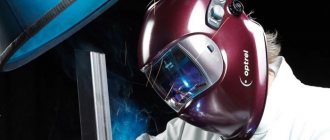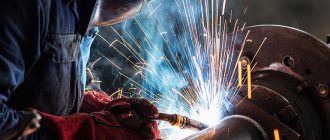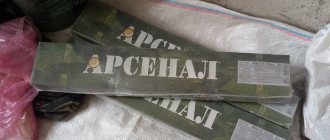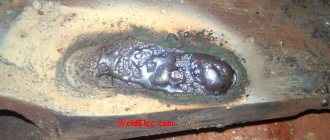The central element of a welder's workplace is the table. What it should be like and how to choose the right one are important issues in organizing a room for welding work. You will find the answers in the article.
- Welding and cleaning
- Siegmund
- Clamps
An integral element of any welding workshop is the table. Without it, doing work will be much more difficult and uncomfortable. It serves as a working platform where metal workpieces are joined, as well as a storage place for a large number of useful items and consumables.
Design
A large selection of welding tables is due to the need for diverse design solutions for specific tasks. But every product has elements that are mandatory and basic:
- tabletop. The working surface is made of durable, non-flammable material. It has many holes and grooves, which are used to secure workpieces during operation;
- frame. A frame to which a tabletop, pull-out shelves and various kinds of organizers are attached;
- adjustable supports. They make it possible to set the tabletop evenly and at the desired height;
- open and closed shelves. The first are used to place electrodes, filler wire and other consumables that should always be at hand. Tools are stored in closed shelves;
- pallet. It is located at the bottom of the table and serves to collect production waste, scale, shavings, etc.;
- brackets. They are located along the contour of the working surface. Hold the welding wire and ground loop;
- suction sleeve. An element of the ventilation system designed to remove exhaust gases and dust.
Tables are the central element of a welder's workspace. They are complemented by other elements for proper organization of space - cabinets, shelves, racks, mobile and stationary tool carts, as well as other equipment.
Dimensional drawings for welding tables
Let's look at several models that differ in complexity, layout and materials used.
The simplest table for welding work
This model is not distinguished by its solid dimensions or high load capacity, but it is very suitable for welding small parts that require fastening in a vice or using clamps.
The basis of the design is a corner 60x60x670 mm, from which the legs are made. The frame, when applied to a regular table, is called a frame, made of a strip 20 mm thick and 100 mm wide. The length of two fragments (on the long side) is 1000 mm, the other two (on the short side) – 620 mm. The strips are welded to the corner from the outside, with the upper edge of the strip being 20 mm higher than the top edge of the corner.
Inside the rigid frame (legs plus strapping) strips of metal 20 mm thick, 100...150 mm wide (not critical) and 580 mm long are laid and welded. If desired, to strengthen the frame, you can weld crossbars along the long and short sides of the table below, at a height of 200...300 mm. If you make them from a corner, you can support a shelf on them.
The tabletop is assembled from a profile pipe or metal strips with a thickness of 30 mm. If a pipe is used, it is advisable to weld its ends with plates. The diagram does not show the gaps between the strips, but in practice it is advisable to leave gaps of 20...30 mm so that the parts can be secured to the table anywhere with clamps.
Mobile welding table on wheels
The compact square model with an additional shelf is especially convenient if welding work must be performed while moving within the room or around the site. The table is designed for standing work, so the height of the table top is higher than usual.
The load capacity in this case is even less than that of the previous model, since a sheet with a thickness of only 3 mm is used for the tabletop, and the corner of the legs has the same thickness.
Please note: when assembling, it is necessary to place the corner of the legs INSIDE the frame from the corner, this stabilizes the structure and makes it neater.
To move the table, standard swivel wheels without a stopper are used (you can use furniture ones, but only metal ones).
Welding table on adjustable legs with perforated tabletop
This model can be called an assembly and welding table, since the perforation of the tabletop allows you to attach many different devices to its surface, making installation easier. This product is also applicable for carpentry, bending wood or metal according to a template, repairs, and so on.
Modification of the model with slightly different dimensions
A support for a metal perforated tabletop with a thickness of 3 mm or more and a hole spacing along the grid of at least 100x100 mm. The diameter of the holes is 10...25 mm, depending on the method of fastening the parts and the size of the devices used (clamps). The perforated sheet has grooves 10 mm wide for installing reinforcing plates on the back side and fastening the sides.
This model uses standard adjustable legs that can withstand the required load. When choosing adjustable furniture legs, you need to make sure that the thread pitch on the adjusting support is sufficient and the strength of the product as a whole.
Examples of using a welding table with a perforated table top
Folding welding table with additional parts
If previous models were easy to make on your own, this design will require good skills as a welder and installer, but it will provide much more convenience during the work process than standard welding tables.
The main part of the product is practically no different from the first version presented. Massive posts and corrugated pipe frames are also used here, but a lower frame is added at the bottom to serve as a support for the shelf. But the side elements are more interesting.
Using hinges, folding parts assembled from pipe with a much larger gap between the elements than in the main tabletop are attached to the front and rear edges of the tabletop. In the working (raised) position, these panels are held by U-shaped stands, fixed to the table posts using a rotating axis.
An additional shelf located on the right, reinforced with braces, has reinforced wheels. With their help, the table can be transported by lifting the opposite edge.
You can see how to make such a design in the video.
Peculiarities
The most important parameter of the equipment and accessories that a welder uses in his work is safety. This can be fully discussed in relation to such a harmless object as a welder’s table. It would be more accurate to say - to his workplace, the central element of which is the table. Among the mandatory conditions for arranging a workplace, several basic provisions should be highlighted:
- Forced exhaust over the table. Active ventilation is necessary to quickly remove harmful gases and dust accumulations from the room.
- They pumped in air. They are necessary for the ventilation to work as efficiently as possible, and for the specialist to continue working for as long as desired.
- Work area lighting. It is important to ensure optimal lighting levels. To do this, it is best to combine natural and artificial light sources.
- A place should be provided for storing work equipment.
An important condition for desktop materials is their complete environmental friendliness: they should not emit substances harmful to human health when exposed to strong heat. This leads to another mandatory requirement: the materials from which the table is made must be non-flammable.
Ventilated welder's workbench
The welder's workbench with ventilation can be in two versions:
- the table with built-in welding is additionally equipped with a suction compressor, which absorbs smoke from the combustion of electrodes and transports it to special afterburning tanks, if the workshop is equipped with them; if not, the smoke is simply removed outside the workshop through an external ventilation system;
Such tables are much more expensive than regular tables, even if you add the separate cost of stationary hoods to their total.
- a table that requires additional ventilation equipment.
Currently, there are a large number of ventilation systems and hoods that are installed in the immediate vicinity of welding work. Effective and inexpensive.
Currently, many companies offer their products, but to choose, you must be guided by the requirements listed above.
This will allow you to choose a table that is ideal for any industrial production.
Welding tables are a product that not only greatly facilitates the work of welders, but also universally facilitates the work of workshop departments.
Application area
The table is used in the process of working on individual orders, which are characterized by a unique design, and for mass production. It should provide maximum comfort and at the same time promote work efficiency. It is not suitable for mounting large-sized products, but it is quite comfortable to assemble individual components of a large structure on a table.
An important advantage of the welding table is the ability to use guides with mobile stops. Additionally, they can be fixed with clamps and other clamps. For example, often the position of the workpiece is fixed using a standard ruler provided on the working surface.
Type overview
Today there are a large number of different models of welding tables. They can be divided into three groups:
- traditional workbench;
- Rotary table;
- universal tables with a set of additional features.
To understand in more detail the functionality of each group of tables, you need to take a closer look at their structure and features.
Crafting table
The simplest option for a mounting surface made of metal. Both the frame and the tabletop are made of metal, which ensures high structural strength. Additionally, the table is equipped with accessories - clamps, angles, clamps, bench vices and other accessories.
Rotary
The next class of equipment in terms of complexity. It has an electric drive, which provides the ability to position the surface according to the angle of inclination or move it along any axis. Such tables are in demand in the production of complex shaped structures. A slot table is a type of rotary structure designed for assembling, stripping and welding workpieces.
Universal
In addition to the functionality of rotary tables, such tables have additional equipment designed to optimize welding, grinding and other operations. The workplace is designed for intensive use, therefore it is equipped with hoods to remove dust and gases from the room.
Types of tables for welders and assemblers
The range of equipment sold is varied: from simple and compact ones, which are suitable for amateurs and home craftsmen, to serious installations with mechanized functionality. Some of the most common types are described below.
Welding and cleaning
The tables are equipped with a fan or a full exhaust system to remove dust and exhaust gases. The tabletop is made from high-strength structural steel that is wear-resistant. It has holes or is made in the form of a lattice.
Universal assembly and welding machines
Before starting welding work, the workpieces are attached to the surface using various devices. If necessary, the tabletop can be dismantled and moved to a position that best suits the task at hand. At the buyer's request, the tables are equipped with additional supports, which make the solution universal.
Transformers
The height, width, and length of the table can vary to suit the dimensions of the structure with which the welder has to work.
Stationary and mobile
There are models of tables that are firmly attached to the base and remain motionless all the time. These are stationary versions. Mobile ones are often equipped with wheels. They are installed on legs and easily rotate around the axis of the fastener. The wheels themselves are made of polyurethane and are equipped with a brake mechanism.
Simple and professional
The first group of welding tables is designed to perform simple operations and simple work on assembling structural components. Professional models are universal in use and have many options for fixing workpieces. They are equipped with an effective exhaust system and allow the installation of additional equipment - grinding, drilling and others.
With ventilation
During welding of metals, a lot of gases - combustion products - are released into the surrounding space. If the welder’s workplace is equipped indoors, then an effective system for removing exhaust gases and dust is needed. Local ventilation is most often used. The suction and removal of combustion products can be performed in the form of autonomous ventilation, or can be connected to a general exhaust hood.
3D
Such models are designed for precise positioning of workpieces in two planes: vertically and horizontally. The devices allow you to weld any parts with a three-dimensional configuration.
Folding, folding, folding
In order to save space indoors, transformable structures are installed. They take up little space and are folded until welding of workpieces or any structure is required.
Nitrided
Characterized by the fact that the surface is nitrided. This gives it special strength and resistance to wear. Scale and molten metal do not stick to the working surface.
Cast iron
Manufacturers offer table models with cast iron surfaces. Cast iron cooks very poorly. Therefore, the advantage of a cast iron surface is that the melt does not stick to it.
Kinds
The entire variety of welding tables can be divided into the following groups :
- classic fixed stationary, mobile, collapsible tables;
- tables, the workspace of which, for ease of work, can be rotated around a vertical axis or rotated around a horizontal one;
- universal, equipped with a ventilation system, where, in addition to welding, work is carried out on stripping workpieces and other work on their processing.
Some typical designs are described below in the text.
Assembly
Some welding structures are quite complex volumetric shapes. Assembly and welding tables complete with special equipment allow for their precise configuration.
Mobile assembly and welding table SibarWelding. Photo by BelSvaMo
3D
The working surface of 3D tables is formed by horizontal and vertical plates, which are perforated with a coordinate grid of calibrated holes of a certain diameter. These holes serve as a base for installing equipment for precise positioning of assemblies in a volumetric configuration. The following is information about some models of 3D tables.
Tempus SST 80/35S
The working surface of this model is made with a coordinate grid of holes with a diameter of 28 mm. with a center distance of 100 mm. Overall dimensions 1400 x 900 x 800 mm . Fixation of products, based on the base of 28 mm holes, is used both for welding single items and in mass production. height adjustable The top plate is nitrided , which provides it with high hardness, corrosion resistance and protection against adhesion of welding spatter.
Welding table Tempus SST 80/35S nitrided. Photo MOSSklad
The use of devices in the form of stops, squares and fixing clamps will allow the plate to be used as a welding conductor in the manufacture of fencing and other prefabricated metal structures.
3D Weld D16
3D welding tables under the German brand are produced by domestic manufacturers. The working surface of the tables is perforated with holes with a diameter of 16 mm . Length dimensions range from 700 mm to 3000 mm.
The working surface is ground and sandblasted to the required roughness. The flatness of the table, made of ST09G2S structural steel, is no more than 0.5 mm per 1 meter of length. Positioning accuracy is ensured by calibrated reaming holes with straightness and perpendicularity of surfaces of less than 0.1 mm per 1 meter of surface.
The design is modular and can be assembled into a line, square or corner. The model has a stationary or mobile design.
Demmeler PROFIPlusLINE (PL) 22
The table is designed for welding small and medium-sized workpieces . Grid of holes with a diameter of 22 mm. made in such a way that significantly increases the possibilities for better fastening of parts. The strength characteristics of the table are calculated using computer technology and have increased values. Linear measuring scale in both plane coordinates improves positioning accuracy.
All technological holes are 22 mm. made with a safety cone . The cone facilitates the installation of equipment and protects the surface from damage to the edges of the table material, especially when using plates made of aluminum alloy.
Special cuffs are placed on the supports to prevent pinching of the welding cable and to protect the threads of the support adjustment unit from contamination.
With swivel mechanism
Tables with a rotating mechanism guarantee the most convenient work for the welder. It will not be difficult to weld in seemingly hard-to-reach places , which, using a rotating mechanism, can be brought closer to an area accessible to the welder for ease of work.
The rotary round table Slot-Table of the PST series is used for assembly, welding, stripping and other positioning of workpieces. Photos Tehnoveld
Welding complete with a rotary table can be easily mechanized and a semi-automatic welding machine can be used to increase productivity. As an example, the rotary welding table IRS-1V-5-011 from.
IRS-1V-5-011
The rotary table is a faceplate rotating around a vertical axis . The rotation mechanism is made in the form of a brushless electric motor, which eliminates the use of transmission mechanisms and facilitates the process of regulating the rotation speed. It can be carried out using a portable remote control and setting the desired rotation speed using a pedal drive. The parts are fastened using grooves in the faceplate and special clamping devices.
The video shows a larger model, but the video gives you an idea of the work.
With hood, ventilation
To create normal working conditions for a welder, especially important for enclosed spaces , it is necessary to equip welding tables with an air exchange system that allows you to effectively remove harmful substances. The table can be equipped with a design in the form of an exhaust hood , the pipe of which is connected to the general circuit of the ventilation system.
Welding table with exhaust duct. Photo Products for welders
Another option is to create an autonomous filter-ventilation unit , where the air, after cleaning, is returned back to the room. An example of such equipment is the ventilation welding table SVS-1200.
SVS-1200
Welding table with dimensions 1685 x 900 x 925 mm. equipped with a filter-ventilation device to remove welding aerosols and dry dust when stripping workpieces. The design provides a special filter chamber , where a filter element, a spark arrestor and a tray for collecting dust after cleaning contaminated air are installed. A spark arrestor , a mesh design, protects the filter element from sparks, which is periodically cleaned of the remaining dust in it using a pneumatic method.
The filter chamber is located inside the body of the welding table, next to which there is a radial fan. Purified air is supplied through a pipe in the side wall.
Large sizes
For welding large parts, tables should be used that have the appropriate weight and dimensional characteristics. Such mechanical welding equipment can withstand heavy loads without deforming the base surfaces. Additionally, it can be equipped with hydraulically driven lifting mechanisms for ease of welding in a vertical plane.
Welding table Professional Extreme 4000x2000x100 mm. Photo VECTOR GROUP
An example of such equipment is the welding and assembly table SGPR-2300 , a Russian manufacturer from St. Petersburg. The overall dimensions of this equipment are 2315 x 1200 x 1500 mm, maximum load 1500 kg. The cast iron platform with T-shaped slots moves in a vertical plane using a system of levers and a hydraulic drive. Once, having fixed the workpiece in the grooves, you can perform work without reinstallation, changing the workspace in the vertical plane. The presence of hydraulic locks will ensure safe operation in the event of a leak in the hydraulic system.
Optimal sizes
The size of the working area is one of the key points that is very important for welders and affects the ability to perform certain jobs. It is this indicator that determines the size of the workpieces that the welder can subsequently work with. The dimensions of the table surface vary over a wide range of values: from small (approximately 70x70cm) to large (298x148cm). in height it should not exceed 1.4 meters.
Tables with a small workspace are used for working with small workpieces or assemblies. Tabletops of impressive dimensions provide more opportunities. You can place a corresponding structure or several nodes on them. Here you can leave the most frequently used equipment, which is easier to keep at hand.
Top brands
It is possible to weld metal workpieces without a special table, but it is very convenient. As a result, the specialist’s labor productivity decreases and the quality of the welded joint suffers. Therefore, a working surface is definitely needed. Today the market offers a large selection of such equipment from famous and unknown manufacturers. Of the total number of brands presented, several of the most popular ones should be highlighted.
Siegmund
The company supplies the market with products that fully comply with generally accepted requirements for welding tables. The manufacturer has equipped the working surface with quick-clamping devices, which helps to increase the welder’s productivity.
Forster
A company from Germany specializes in the production of modular options. The countertops are made of ferrite or cast iron and can be easily removed if necessary. This allows you to change the shape of the table in order to adapt it as much as possible to a specific workpiece. The brand supplies rotating, lifting and rotating type products.
Demmeler
The brand belongs to a German manufacturer specializing in the manufacture of welding tables and additional equipment for them. The main advantage of the products is the versatility of the solutions.
"WTO Plant"
The Ulyanovsk company produces a fairly large range of non-standard equipment and accessories. Prefabricated welding tables are practical and come with additional accessories to increase productivity and improve working conditions.
VTM
The Russian brand specializes in the production of standard welding equipment and custom-made metal structures. The main focus is the production of D16 and D28 systems, as well as the execution of individual orders. The parameters of the finished product exactly correspond to the customer's requirements. For the production of welding tables, only high-quality certified materials and components are used.
Evidence
The main direction of the company is the production of welding and installation equipment. The main advantage is the wide range of models offered, which allows you to find the option that best suits your needs.
ESAB
Perhaps the most recognizable brand on the domestic market. The Swedish brand supplies high-quality welding equipment, including tables. In addition, its assortment includes a large selection of other equipment, consumables and accessories.
Sovplym
A joint venture created by businessmen from Russia and Sweden. Production facilities are located in St. Petersburg and supply ventilation systems to the consumer market. One of the company’s areas of work is the production of filter and ventilation devices for welding tables.
TEMPUS
The German manufacturer supplies 3D tables to the domestic market. They are excellent for solving problems of welding and installation of frames, fences and a whole range of other products.
Table-Table
The Russian company specializes in the production of welding tables, the table tops of which consist of stacked plates. The typesetting elements themselves are made of cast iron and aluminum, to which molten splashes do not stick. The plates are easily removable, which allows you to transform the working surface to suit specific workpieces or structures. Production processes can be simplified. For this purpose, the table can be equipped with various hydraulic and electromechanical drives.
SIBAR
A young domestic company is creating its own range of products. takes into account the needs of customers as much as possible.
Requirements
3D welding tables Tempus SST fix series. Photo Welding Center
In addition to ensuring electrical safety conditions, the specifics of welding work impose the following requirements .
- The presence of sparks during welding work is the basis for fire safety requirements for the table design. It must be made of non-flammable materials and have barriers, for example, made of asbestos plates, to prevent sparks from reaching neighboring objects. Fire safety requirements regulate the presence of a fire extinguisher at the workplace, or, in extreme cases, a bucket of water.
- The dimensions should ensure comfortable work for the welder. Depending on the tasks assigned, the table is equipped with mechanisms that can change its size and shape.
- The material is selected with the condition that it cannot be burned during operation. Welding spatter should not stick to the surface.
- Workplace lighting should be done using 24 V incandescent lamps . Light from other sources, such as fluorescent lamps, can penetrate the welder's shield, thereby creating glare and interfering with work.
How to choose?
Choosing the most suitable table for specific tasks is not so easy. After all, many factors have to be taken into account and it is possible that new circumstances may arise in the process of work. That is, if possible, it is necessary to provide for the maximum possible number of working moments.
Those who prefer comfortable working conditions and put them at the forefront should pay attention to round models of welding tables. They are usually rotating. Therefore, the entire range of problems (or most of them) can be solved without changing your location. Such equipment is mounted on a prepared concrete platform. If you plan to produce complex structures, you should choose a work surface with a set of additional equipment that would make it easier to complete the tasks.
Fortunately, manufacturers produce a wide range of welding tables and there really is plenty to choose from. Structures are often equipped with special equipment and equipment designed to perform highly specialized operations. And if you need universal equipment, then finding it will not take much time.
When choosing a welding table, experienced specialists advise paying attention to the following recommendations:
- The first step is to determine the optimal dimensions of the structure. They must meet production requirements and at the same time be comfortable for a specialist. If you lose sight of this point, welding work can become an unpleasant and even dangerous process.
- It is important that the work area is fenced. This is a kind of protective screen. It must be made of fire-resistant materials.
- The table should have a decent weight. At least 180-200 kilograms. Thanks to this, it will be rigid and quite stable.
- It is necessary to abandon energy-saving lamps. Their light creates glare, which is a source of discomfort while doing work.
- A big plus is the presence of a rotating platform. It is advisable to purchase just such models.
Sometimes the table lacks integrated ventilation. Then you definitely need to purchase it separately. As an option - a small exhaust device with magnets.
If it was not possible to choose something appropriate from the presented models, then you can order the manufacture of the structure according to individual drawings. Thanks to this approach, the owner will receive a welding table that will best meet his requirements. At the same time, you will not have to overpay for unnecessary functions or devices.
Comfortable working conditions cannot be created without the appropriate tools. You should pay special attention to his choice. It is important that fastening devices and clamps securely hold the workpieces in the desired position and make it possible to quickly change the position of the workpieces being connected.
When buying a table for a home workshop or small business, universal models are best suited. They are suitable for more than just welding work. On such surfaces you can fix a part for grinding, sharpening, drilling or performing any other technological operations.
Equipment
To speed up welding work as much as possible, you need to take care of purchasing special equipment and devices. Basic requirements for auxiliary equipment:
- must ensure the desired location of the joined workpieces. In this case, you will not have to additionally adjust the parts;
- during welding, the edges must be at a certain equal distance in relation to each other. This is easy to achieve with the right tools;
- auxiliary equipment should be placed on the work table and not interfere with the performance of various technological operations.
It is difficult to weld parts without fixing them in a certain position. Various types of clamps, clamps, clamps and clamps cope well with this task. There are several types of fixing devices, which are divided into groups according to the type of drive:
- mechanical;
- hydraulic;
- pneumatic.
Hydraulic and pneumatic clamps are equipped with strong links, which provide the ability to brake parts automatically. This design prevents unauthorized loosening of fasteners. It is important to ensure clear joining and fixed fixation of the elements before welding them. Otherwise, the seam may turn out to be of poor quality. It is noteworthy that the preparatory work very often takes more effort and time than the welding process itself.
In addition to the clamps supplied with the tables, other devices for fixing workpieces can be used.
Clamps
A separate subtype of clamps that holds workpieces at a given angle. There are many options for devices that differ in both shape and size. The design includes a pin on which there are clamps.
Prisms
Fixing devices designed to hold bulky workpieces. To keep the part stationary, it is fixed using prisms at an angle. The main disadvantage of this type of holder is the fact that marks of fixation often remain on the surface of the workpiece.
Cast iron plates
In budget models of welding tables, cast iron plates replace the tabletop. The main advantage of this solution is that if one of the plates fails, it can be easily replaced. Another plus that you should pay attention to is the low thermal conductivity of cast iron. Even with prolonged operation of the welding machine, it does not heat up to high temperatures. In addition, the metal is characterized by high resistance to static loads.
Vise
Mechanical unit for holding workpieces. They are used in the welding process, as well as subsequent (or preliminary) processing of workpieces. The main feature of the vice is the fact that the specialist has both hands free and it is easier for him to perform the necessary manipulations. There are several types of vices.
Plate
In fact, it is the same tabletop, but with a perfectly flat surface due to its thickness. The choice of plate size is determined depending on the size of the workpieces that will have to be worked with in the future. The advantages of the plate include markings for placing parts on the surface. The metal sheet has several holes that can be used to secure workpieces using other equipment.
Suction sleeve
A lot of welding work is now done indoors. It is important that they have active ventilation, which will remove combustion products and dust outside. A forced ventilation system is sometimes used as a primary or additional workpiece holding system. The suction pipe is located under the table and the air flow, passing through small holes in the table, presses the part to its surface.
Materials for welding table
Metal is almost always used as the load-bearing frame of a table for welding work.
The photo shows a mobile model on a rigid frame made of a profile pipe with a cross-section of 60x60 mm and a wall thickness of 2 mm. The frame is made by welding, the sidewalls are additionally reinforced with reinforcing bars. A profile pipe with a cross section of 60x140 mm was used as a surface for the desktop. This design weighs about 150...200 kg, which is quite enough to provide the required load capacity.
Below are the profiles of square and rectangular hot-rolled steel pipes that are suitable for making the load frame of welding tables. You should immediately pay attention to pipes with a wall thickness of 2 mm or more, since a pipe with a wall of 1.5 mm may not have sufficient strength when working with large parts.
It is not necessary to use a closed profile - it is permissible to use a channel or other similar type of rolled product.
Interestingly, the surface of the desktop is almost always made with gaps. This is necessary so that parts can be secured to its surface with clamps and other devices to hold the products in the desired position.
In addition to tabletops made of strips, a perforated option is often used.
In this case, a steel strip is used (as shown in the photo) or a solid sheet. Hole diameter – 10…25 mm.
The thickness of the sheet (strip) for normal operation should be at least 8...10 mm, preferably more. This also increases the weight of the product and contributes to its stability and better distribution of the load across the tabletop. Unfortunately, the cross-section and wall thickness of the profile of the support posts also have to be increased.
For small parts that do not need to be fixed to the work surface, a table top made of sheet metal with a thickness of 8...20 mm is suitable. Shelves and drawer bottoms for items that aren't too heavy are often made from wire mesh or thinner solid or perforated sheet metal.
In some cases, it is permissible to use OSB or thick plywood for non-critical (hot objects will not be placed on them, sparks will not fall on them) shelves.
Important: if any materials or equipment that cannot tolerate high temperatures will be stored under the tabletop of the welding table, it is advisable to insulate the tabletop. To do this, it is necessary to use NON-FLUSTIBLE heat insulators - basalt or mineral wool, basalt cardboard, asbestos and the like.
To protect wooden shelves and drawers made from wood substitutes from sparks and scale, metal sheets 1...5 mm thick are laid on top of them.
The last point regarding materials and components: legs for mobile welding tables must have a stopper and be designed for the weight of the product. The use of non-locking wheels is permissible only for small products intended for rare work.
